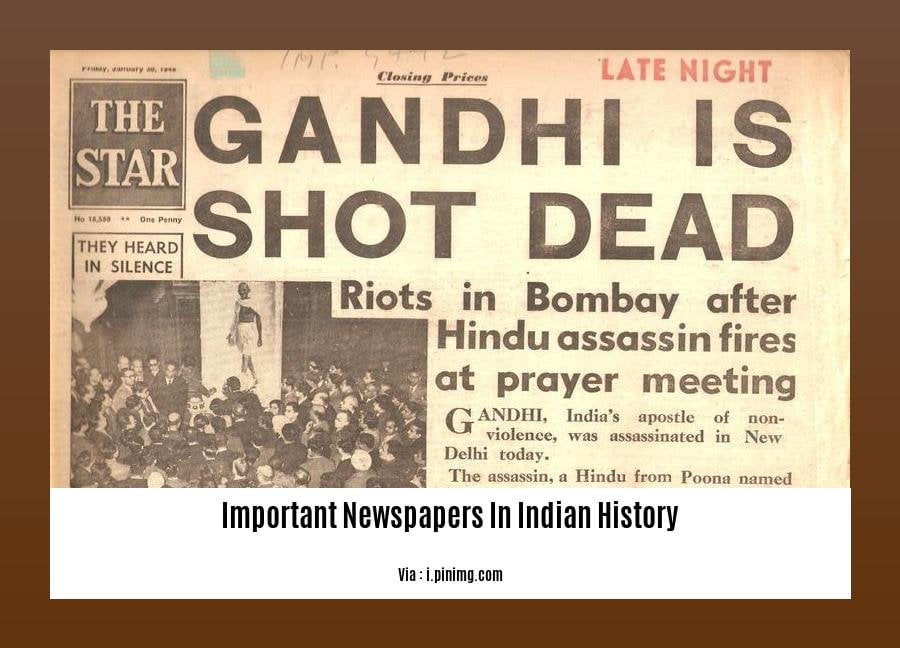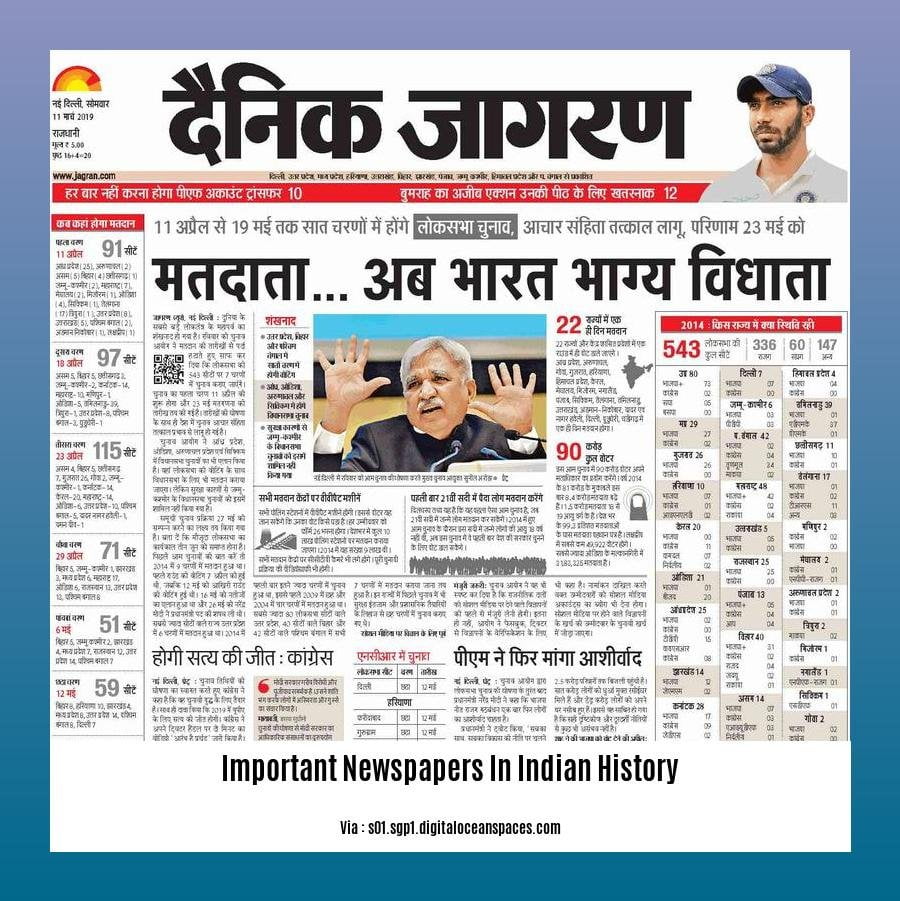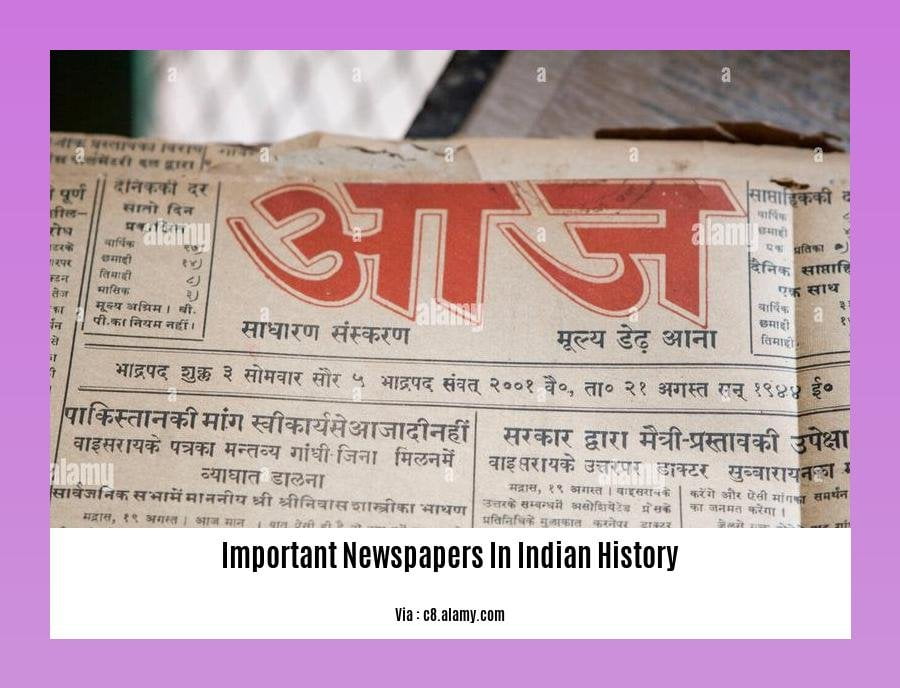Embark on a captivating journey through the annals of Indian history, where the written word wielded immense power. Discover the profound impact of newspapers in shaping the nation’s destiny, as they emerged as torchbearers of truth, catalysts for change, and guardians of democracy. From the earliest pioneers to the modern giants, each publication played a pivotal role in chronicling India’s trials, tribulations, and triumphs. Prepare to witness a historical panorama of influential newspapers that transformed the way news was disseminated across the Indian subcontinent—a narrative that will leave you inspired, informed, and in awe of the indomitable spirit of journalism.
Key Takeaways:
- Bengal Gazette:
- First published in 1780 in Calcutta by James Augustus Hickey.
Known for its outspoken criticism of British rule.
Samachar Darpan:
- Founded in 1818 by John Clarke Marshman.
Focused on providing news in the Bengali language.
Mirat-ul-Akbar:
- Established in 1822 by Raja Ram Mohan Roy.
A Persian-language newspaper advocating for social and religious reforms.
Bombay Times:
- Published in Bombay in 1838.
One of the first newspapers to be published in English in India.
Hindoo Patriot:
- Founded by Harishchandra Mukhopadhyay in 1853.
Played a significant role in the Indian independence movement.
Som Prakash:
- Founded by Ishwar Chandra Vidyasagar in 1858.
A Bengali-language newspaper focused on social and cultural issues.
BANGADARSHAN:
- Founded in 1872 by Bankim Chandra Chatterjee.
A Bengali literary magazine that also published political commentary.
The Hindu:
- Established in 1878 by G. Subramania Iyer in Chennai.
- Still in publication today, it remains one of India’s most influential newspapers.
Important Newspapers in Indian History

In the annals of Indian history, important newspapers have played a pivotal role in shaping the nation’s trajectory. These journalistic trailblazers not only disseminated news and information but also emerged as powerful catalysts for social, political, and cultural change. Their ink-stained pages served as battlegrounds for ideas, igniting movements that would eventually transform the subcontinent.
Forging a New Narrative: The Bengal Gazette
In 1780, James Augustus Hickey, an Irish adventurer, dared to challenge the status quo with the launch of the Bengal Gazette, India’s first newspaper. Hickey’s audacious venture, published from the heart of Calcutta, fearlessly critiqued the British East India Company’s rule, earning him the ire of the colonial authorities. The Bengal Gazette stood as a beacon of free speech, paving the way for a vibrant journalistic landscape in India.
A Voice for Vernacular Expression: Samachar Darpan
In 1818, John Clarke Marshman, an English Baptist missionary, recognized the need to bridge the linguistic divide in India’s media landscape. He founded Samachar Darpan, the first newspaper published in Bengali, India’s most widely spoken language. By disseminating news and information in the vernacular, Samachar Darpan empowered ordinary Indians to engage in public discourse and participate in the shaping of their nation’s destiny.
Championing Social Reforms: Mirat-ul-Akbar
Raja Ram Mohan Roy, a pioneering social reformer, recognized the power of the press to advocate for change. In 1822, he established Mirat-ul-Akbar, a Persian-language newspaper that fearlessly championed social and religious reforms. Roy’s writings sparked a wave of progressive thought, challenging orthodox practices and advocating for the rights of women and the underprivileged.
A Window into the West: Bombay Times
In 1838, the bustling city of Bombay (now Mumbai) witnessed the birth of the Bombay Times, one of the first newspapers to be published in English in India. The Bombay Times served as a bridge between India and the West, bringing news and ideas from across the globe to the shores of the subcontinent. It played a crucial role in shaping the intellectual discourse of the time, exposing Indians to new perspectives and challenging their worldview.
A Clarion Call for Independence: Hindoo Patriot
Harishchandra Mukhopadhyay, a visionary journalist, founded the Hindoo Patriot in 1853. This Bengali-language newspaper became a powerful voice in the Indian independence movement, fearlessly advocating for self-rule and condemning British colonial rule. The Hindoo Patriot inspired a generation of freedom fighters and played a pivotal role in galvanizing support for the cause of Indian independence.
These are just a few examples of the many important newspapers that have left an indelible mark on the course of Indian history. Through their courageous reporting, insightful commentary, and unwavering commitment to truth and justice, these journalistic pioneers have shaped public opinion, influenced policy, and ignited social and political movements. Their legacy continues to inspire generations of journalists and historians, reminding us of the enduring power of the press to inform, educate, and transform society.
Who doesn’t want to know the history of Korea? There are many historical places and events in Korea that have shaped its rich history. If you want to learn more about the history of Korea, click here to learn about the history of Whoo Korea and its historical significance.
Before Nigeria’s independence in 1960, the country had a rich history and culture that shaped its identity. To learn more about the political, social, and economic development of Nigeria before independence, click here: Nigeria history before independence.
The Hindu and Swadesamitran: Shaping the Nationalist Discourse

History is not merely a string of events, but a vivid tapestry woven with stories of struggle, triumph, and change. Newspapers play an indispensable role in rendering the strokes of this tapestry, documenting the winds of change. In India, two towering newspapers, The Hindu and Swadesamitran, stand out as pioneers in shaping the national discourse during the independence movement.
Forging the Flame of Nationalism
The Hindu, founded in 1878, and Swadesamitran, established in 1882, were more than just newspapers; they were torchbearers of the nationalist spirit. Their pages carried the fiery rhetoric of freedom fighters, stirring the hearts of millions towards self-rule.
Swadesamitran, published in Tamil, catered to the masses, echoing their grievances and igniting the flame of nationalism. The Hindu, with its English readership, echoed the sentiments of the educated elite, deriding the British Raj and advocating for swaraj.
A Voice for the Voiceless
The Hindu and Swadesamitran served as platforms for the voiceless, highlighting the rampant corruption, racial arrogance, and economic exploitation perpetrated by the British regime. Their fearless reportage shed light on the dark corners of colonial rule, emboldening Indians to demand their rights.
Celebrating Cultural Identity
Beyond their political role, these newspapers also championed cultural nationalism. They published articles and essays promoting indigenous languages, art, and literature, fostering a sense of pride in India’s rich heritage.
Key Takeaways:
- The Hindu and Swadesamitran were influential newspapers that played a pivotal role in shaping the Indian independence movement.
- They provided a platform for nationalist leaders to express their views and mobilize public opinion against British rule.
- The newspapers also highlighted the social and economic problems caused by colonialism, and advocated for reforms.
- Swadesamitran, published in Tamil, played a significant role in reaching out to the masses and mobilizing support for the independence movement in South India.
References
- Swadesamitran: The Newspaper That Fought for India’s Independence
- The Hindu: A Newspaper That Shaped India’s History
The Times of India: A Chronicle of Colonial and Post-Independence India
Imagine a colossal tome, its pages holding the essence of a nation’s past. Welcome to the world of The Times of India, an indomitable force in the chronicles of Indian history. Since its genesis in 1838, it has been a beacon, illuminating the corridors of power, shaping public opinion, and leaving an indelible mark on the country’s destiny.
A Mirror to the Colonial Era
In the throes of colonial rule, The Times of India emerged as a platform for dissent, critique, and unwavering resistance. It unmasked the injustices of the British Raj, giving voice to the voiceless and kindling the flames of freedom. Articles penned with audacity and determination ignited the spirit of rebellion, inspiring countless Indians to rise against their oppressors.
A Catalyst for Change
From the tumult of colonialism, India emerged as an independent nation, and The Times of India transformed into a harbinger of change. It championed the cause of nation-building, urging the government to address the pressing issues of poverty, illiteracy, and social inequality. Its pages echoed with calls for economic reforms, industrial progress, and the empowerment of the marginalized.
A Chronicle of Our Times
In the decades that followed, The Times of India continued to chronicle the trials and triumphs of a burgeoning nation. It reported on wars, famines, natural disasters, and political upheavals. It celebrated the achievements of India’s leaders, artists, and scientists. It documented the evolution of Indian society, capturing the changing mores, aspirations, and dreams of its citizens.
Key Takeaways:
- As a prominent newspaper that chronicles Indian history, The Times of India has evolved from a colonial mouthpiece to an unrelenting champion of independence, a beacon of hope during nation-building, and a mirror of contemporary society.
- It has played an instrumental role in shaping public opinion, driving social change, and holding the government accountable.
- The newspaper’s pages bear witness to the trials and tribulations of India’s journey from colonial rule to a modern, vibrant democracy.
Citations:
The Times of India (1838–2010) – ProQuest
The Times of India (1838-2001) – ProQuest
The Indian Express: A Voice of Independent Journalism
Unveiling the Legacy of Independent Journalism
Since its inception in 1932, The Indian Express has consistently upheld its commitment to providing credible and fearless journalism. Founded by the visionary Shri Ramnath Goenka, the newspaper has played a pivotal role in shaping India’s media landscape. With its bold reporting, The Indian Express has earned a reputation for truth-telling, holding the powerful accountable, and giving voice to the voiceless.
Early Years:
In the early years of its existence, The Indian Express actively participated in the fight for India’s independence. Through its fearless reporting and editorial stance, the newspaper became a powerful tool in raising awareness and mobilizing public opinion against British colonial rule.
The newspaper’s commitment to truth and justice was evident in its unwavering coverage of sensitive issues such as the Bengal Famine and the Quit India Movement. The Indian Express fearlessly exposed the atrocities committed by the British authorities, shedding light on the grim realities of colonial rule.
Post-Independence Era:
In the post-independence era, The Indian Express continued its tradition of fearless journalism. The newspaper played a crucial role in holding the government accountable and highlighting issues of national importance.
Under the leadership of Ramnath Goenka’s daughter, Indian Express Group Chairperson Shobhana Bhartia, the newspaper has maintained its commitment to independent journalism. The Indian Express has consistently broken stories that have had a significant impact on the course of events in India.
The newspaper’s fearless reporting on issues such as corruption, human rights abuses, and social injustices has earned it accolades and respect from readers and journalists alike.
In 1999, the Express group also launched the website, Indian Express.com, which has since become one of the most widely read online news portals in India.
Key Takeaways:
- The Indian Express has been a trailblazer in Indian journalism for over 80 years, setting high standards of ethics, integrity, and professionalism.
- The newspaper’s commitment to fearless and independent journalism has earned it a reputation as a trusted source of information for readers across the country.
- The Indian Express has played a pivotal role in shaping the course of Indian history, from the struggle for independence to the present day.
Sources:
FAQ
Q1: What role did the Bengal Gazette play in Indian history?
A1: Published in 1780, the Bengal Gazette was known for its bold criticism of the British government, making it a significant voice in the early days of Indian journalism.
Q2: What was unique about Samachar Darpan?
A2: Founded in 1818, Samachar Darpan stood out by providing news and information in Bengali, catering to a broader audience and fostering the growth of vernacular journalism in India.
Q3: How did Raja Ram Mohan Roy contribute to Indian journalism through Mirat-ul-Akbar?
A3: Established in 1822, Mirat-ul-Akbar, a Persian-language newspaper, championed social and religious reforms under the leadership of Raja Ram Mohan Roy, advocating for progressive ideas during a transformative period in Indian history.
Q4: What was the significance of the Bombay Times in the Indian context?
A4: Published in 1838, the Bombay Times holds its place as one of the first English newspapers in India. It played a pivotal role in disseminating information and shaping public opinion during a time of significant social and political change.
Q5: How did Swadesamitran contribute to the Indian Independence Movement?
A5: Founded in 1882, Swadesamitran, a Tamil-language newspaper, played a crucial role in the Indian Independence Movement by highlighting the corruption and arrogance of British officials, becoming a powerful voice for self-governance and national pride.
















